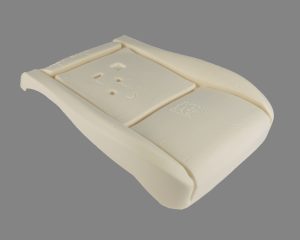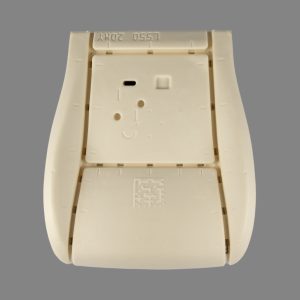
A prevalent trend in the automotive industry is to achieve a lower overall CO2 footprint. Several technologies play a part, including new materials specifications, parts miniaturisation, sustainable manufacture and using the automobile as a source of recycled materials. However, we have long reached the point where the return on developing new polymer grades is often insufficient to justify the expenditure; so automotive materials engineers have to look elsewhere to shave more weight off their designs.
Miniaturisation – the ability to produce microplastic components with high precision – achieves this goal not through the use of innovative polymers, but via the development of micro moulding processes. Its impact is not just limited to the automotive sectors, but in a wide range of other industries as well, including medical, electronics and telecommunications. Watch for my next article focused on micro moulding.
The Role of Critical Material Recovery in Automotive Recycling – according to a December 2024 report by Jack Howley, Technology Analyst at IDTechEx (Ref 1), with over 100 million electric vehicles (EVs) expected to reach end-of-life over the next two decades, automotive scrap is rapidly becoming a more attractive source of critical materials than many primary mineral sources, especially in the metallic field.
The automotive manufacturing industry is among the largest consumers of primary raw materials such as steel, aluminium, copper, and plastics, but makes little use of recycled materials. Although the recycling rates of materials from ELVs are generally high, the scrap metals produced are of low quality and only small amounts of plastic are recycled.
The sector’s reliance on critical materials for decarbonization will fundamentally change end-of-life vehicle recycling and metal value recovery. The recovery of valuable platinum, palladium, and rhodium used in catalytic converters for emission control has long supported the auto scrap recycling market. However, greater vehicle electrification means that the critical metals and rare-earth elements (REEs) used in Li-ion batteries (LIBs) and electric motors are emerging as a primary value opportunity.
Work smarter and win more, with powerful software to manage regulatory, supply chain and sustainability challenges, learn more about ULTRUS here!
Polymer recycling
What of polymers? It is harder to identify valuable recycling opportunities with polymers. However, one good example which has emerged towards the end of 2024 is that in Germany, Adient, Jaguar Land Rover (JLR) and Dow have worked together to produce seat foam for luxury cars using closed-loop recycled components. This is believed to represent an industry-first in the automotive sector.
In order to address the environmental impact of the polyurethane (PU) foams used in car seats, the industry partners decided to team up. So-called ‘post-consumer’ PU moulded foams have been collected from end-of-life vehicles, sorted, and shredded. From this basis, Dow is producing a new, circular polyol, which is subsequently processed and integrated into Adient’s seating formulas. As a result, the Adient Front Seat Cushion prototypes are currently composed of 20% re-polyol from PU end-of-life vehicles.

1 Front Seat Cushion Prototype Left Side (courtesy Adient)

2 Front Seat Cushion Prototype Top View (courtesy Adient)
What are circular polyols?
In general, circular polyols are a sustainable alternative to reduce waste and promote circular economy principles. Reduced circular polyols are made from post-consumer or post-industrial waste, such as used mattresses, furniture cushions and automotive parts.
The process includes collection and sorting, chemical depolymerization, purification and fractionation, and reformulation and processing.
Circular polyols have several benefits, including:
- Reducing carbon footprint: circular polyols can reduce a product’s carbon footprint by 20–30% compared to a fossil-based polyol.
- Recycling difficult materials: circular polyols make it possible to recycle materials that are harder to recycle than thermoplastics.
- Reusing materials: circular polyols can be reused as a raw material to produce new polyurethane foam for mattresses and other upholstered furniture.
- Lowering consumption of virgin raw materials: circular polyols can reduce the amount of virgin raw materials that are consumed.
This milestone positions PU at the heart of a circular economy system. By integrating recycled components into luxury vehicle seat foams, the partners are not only reducing the environmental impact but also paving the way for a more sustainable future in automotive manufacturing.
“Developing components with closed-loop recycled foams spurs us on to further increase the proportion of recycled materials in our seating systems in the future,” says Frank Toenniges, Director Sustainable Product Design & Business Process Improvements at Adient. “Additionally, it positions the actors along the value chain favourably to comply with the proposed European End-of-Life Directive.”
We help companies, mitigate risk and earn trust among stakeholders to whom companies demonstrate health and sustainability in their product lines, facilities and supply chains, learn more about Sustainability and Environment services here!
The European Union (EU) ELV Directive
Every year, over six million vehicles in Europe reach the end of their life and are treated as waste. When end-of-life vehicles (ELVs) are not properly managed, they can cause environmental problems and the European economy loses millions of tonnes of materials.
The Directive on end-of-life vehicles (ELVs) sets clear targets for the reuse, recycling and recovery of ELVs, aiming to prevent or limit waste from end-of-life vehicles and their components and improve the environmental performance of all economic operators involved in the life-cycle of vehicles. It also prohibits the use of hazardous substances when manufacturing new vehicles (especially lead, mercury, cadmium and hexavalent chromium) – except in defined exemptions when there are no adequate alternatives. The exemptions are listed in annex II of the Directive.
Since this Directive was introduced, the EU has also introduced several related rules such as the Directive on the type-approval of motor vehicles regarding their reusability, recyclability and recoverability.
Andrea Debbane, Chief Sustainability Officer at JLR stated: “This breakthrough is a great example of how the automotive value chain can work as a collective to demonstrate that full circularity is feasible and unlock meaningful change at scale. This way of working holds significant potential for increasing sustainability and is critical to JLR’s transition to more circular vehicles.”
As a next step, further research will be conducted to increase the percentage of re-polyol content. At the same time, the closed-loop seat foam will be tested with JLR on a production scale from early 2025.
Reference
The Rise of Critical Material Recovery in Automotive Recycling
Author: Dr Jack Howley, Technology Analyst at IDTechEx
https://www.idtechex.com/emails/16749
Illustrations
1 Front Seat Cushion prototype_Left Side (courtesy Adient).jpg
2 Front Seat Cushion prototype_Top View (courtesy Adient).jpg
The views, opinions and technical analyses presented here are those of the author or advertiser, and are not necessarily those of ULProspector.com or UL Solutions. The appearance of this content in the UL Prospector Knowledge Center does not constitute an endorsement by UL Solutions or its affiliates.
All content is subject to copyright and may not be reproduced without prior authorization from UL Solutions or the content author.
The content has been made available for informational and educational purposes only. While the editors of this site may verify the accuracy of its content from time to time, we assume no responsibility for errors made by the author, editorial staff or any other contributor.
UL Solutions does not make any representations or warranties with respect to the accuracy, applicability, fitness or completeness of the content. UL Solutions does not warrant the performance, effectiveness or applicability of sites listed or linked to in any content.
